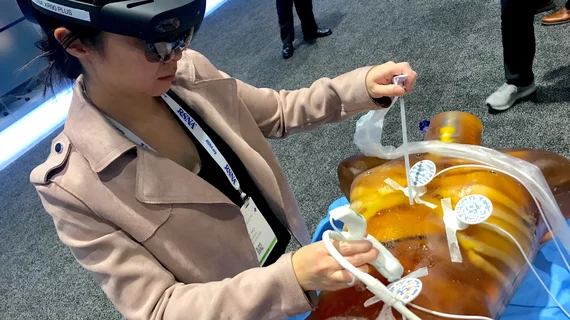FDA move signals a forthcoming increase in the use of virtual and augmented reality devices in radiology
Following years of hype surrounding the use of artificial intelligence in radiology, virtual and augmented reality software and devices are now becoming one of the field’s most talked about trends.
The applications for virtual/augmented reality (VR, AR) are particularly beneficial in helping radiologists and radiology trainees fine-tune procedural skills needed in real-world clinical scenarios. This was evident recently at this year’s annual meeting of the Radiological Society of North America, where the show floor hosted a number of examples of the technology, including a packed hands-on VR session in neuroimaging.
VR and AR technology allows clinicians to practice skills in interventional procedures, cardiac measurements, surgical navigation and more. AR works by overlaying simulated digital imagery onto a patient or specified training area, creating an augmented experience through the use of a camera. For example, NovaRad has a device that allows providers to overlay CT or MR images over a patient in real-time while they are on the table.
VR technology uses a headset to offer users an immersive experience in a virtual environment that mimics real-world clinical scenarios. An example of this technology was developed recently at Columbia Clinical Innovation Lab, where experts sought to provide medical students with VR training that would enhance their skills in ultrasound-guided central line placement.
The applications for VR/AR devices are wide-ranging, and could be particularly beneficial in underserved areas where patients have less access to care and clinicians have fewer opportunities to train. Numerous applications have been deployed over the last several years, but their use has become increasingly common recently.
So common, in fact, that the U.S. Food and Drug Administration recently felt compelled to release a list of AR and VR medical devices that are currently legal to be marketed in the U.S. through 510(k) clearance, De Novo classification or Premarket Application Approval. This move was made following recommendations the FDA received at the CDRH Patient Engagement Advisory Committee (PEAC) held in July 2022.
Although not comprehensive, the list currently includes 39 devices, including 14 dedicated to radiology specifically. And the FDA has stated that this number is expected to grow, as all indications point to the trend of VR/AR use in medicine to continue.
To view the list, click here.

